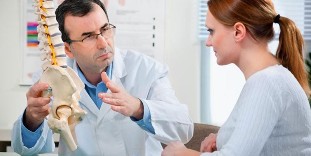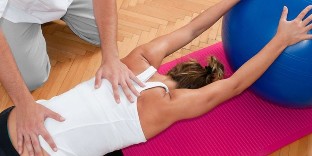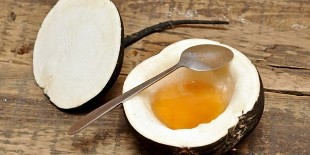In the medical literature, the term "spinal osteochondrosis" means a degenerative process in the centers of oscillation in children. Common medical diseases, considered the most common of all musculoskeletal system problems, are hidden behind the words sciatica, herniation disc, dorsalgia (back pain). The lower back, according to official statistics, suffers more often than other parts, causing severe complications for the whole body. Why is this happening and how to treat osteochondrosis?
What is lumbar spine osteochondrosis
Degenerative neuro-orthopedic disease that affects the intervertebral disc and leads to secondary compensatory and reactive changes in the osteo-ligament apparatus and the nervous system - this is the definition given by the doctor of osteochondrosis. This mainly affects the lumbar region, which is located between the thoracic and sacral and consists of five vertebrae. There are discs between them - fibro-cartilaginous formations, formed of the following elements:
- cartilage tissue (membranes involved in the nutrition of discs from the vertebral body ducts);
- pulposus nucleus (gelatinous mass in center with pulposus nucleus);
- annulus fibrosus (protects the fluid part).
Against the background of problems with blood circulation, changes in the composition of cartilage tissue, dehydration of the pulposus nucleus, elasticity and elasticity of the intervertebral disc deteriorate, the nature of its fixation suffers. Under the influence of adverse factors, the fixation of weakened muscles and vertebrae acquires excessive movement. Next, degenerative and destructive processes affect the surface of the adjacent vertebral bones, dystrophy (malnutrition) of the spine occurs.
The next process looks like this:
- Microcrack appears in a loose annulus. The nucleus pulposus begins to penetrate into it, gradually penetrating the fibrosus and damaged annulus, leading to a herniated disc or protrusion (early stage).
- Hernia compresses the spinal canal, can pinch nerve roots and blood vessels, causing pain and problems with movement.
- Due to increased pressure on the vertebrae (from disc thinning), accelerated bone tissue production begins and spinous processes (osteophytes) are formed.
Reason
Some experts tend to refer to lumbar spine intervertebral osteochondrosis and others as "a disease of civilization", mainly due to upright posture, which has increased the load on the back of modern people. Often the disease begins in people over 30 years of age, in men it is more often diagnosed than in women.
Lumbar osteochondrosis can develop:

- excessive load on spinal space (household, professional, sports);
- weak back muscles;
- incorrect distribution of household load on the spine (for lumbar spine - the most common cause);
- frequent back muscle tension;
- overweight, especially with a background of diabetes mellitus;
- spinal cord injury;
- violation of metabolic processes;
- improperly fitted shoes, flat feet;
- problems with posture, providing uneven load distribution along the spine;
- lumbar spine hypothermia;
- sedentary lifestyle, long-term driving;
- hormonal disorders (especially in women);
- congenital pathology of the musculoskeletal system;
- age (natural changes in fibrocartilaginous tissue occur in people over 50 years of age);
- frequent stress, emotional stress.
Developmental level
The course of the disease is slow and gradual, with most patients only realizing serious problems at stage 2 or later. Without proper treatment, osteochondrosis develops and can lead to disability.
Primary Medical Classification:
- The initial stage is characterized by the beginning of the process of destruction of the intervertebral disc, its decrease in elasticity, its elasticity. The disease makes itself felt especially with the load on the spine.
- The destructive process affects the annulus fibrosus, the distance between the vertebrae decreases (the disc becomes thinner), the shrinkage suffers, the protrusion appears (protrusion of the intervertebral disc without breaking the ring). Pinching of nerve roots and inflammation of tissues occur, which increases the pain syndrome.
- The fibrosus annulus ruptures, a hernia occurs. Ship, nerve endings compressed. Changes in the lumbar spine cause general deformities in the spine.
- In the final stage, muscle atrophy of the affected part, motor activity and ability to work suffer. The vertebral column looks bent - there is scoliosis (3-plane deformity), lordosis (anterior deflection of the lower back hypertrophy).
Symptoms of lumbar osteochondrosis
The clinical manifestations of the disease depend on its severity. The main symptoms are local pain syndrome that occurs in response to physical activity, weight lifting, lower back hypothermia, prolonged maintenance of uncomfortable posture (in a sitting position higher than the vertical one). It is caused by irritation of the sinuvertebral nerve (recurrent).
The degree of osteochondrosis of the lumbar spine looks like this:
- In the early stages, there is discomfort in the lumbar region, pain is rare, especially with high loads on the back. They passed quickly.
- At stage 2, lumbar spine movement decreases, pain occurs after physical exercise and without it (with a strong cough, changes in body posture), gradually increases, persists for a long time. Damage in the work of internal organs is possible.
- With the development of osteochondrosis, the pain becomes permanent (permanent), and the vertebrae are deformed. The nerve endings are pinched, so that pain can be given to the sacrum, legs, become sharp, shoot. Loss of limb sensitivity, back, thighs, numbness, paresthesia (burning, tingling, "shivering") occur. Pelvic organ dysfunction appears.
- In the last stage, motor function is disrupted or becomes completely impossible, curvature of the spine occurs. The pain persists, people unconsciously take the improper position to alleviate it.
Disease reflex syndrome in formal medicine is intended for 3 groups: muscle-tonic, neurodistrophic, vegetative-vascular. The last 2 categories manifest themselves clearly in the 3 stages of the disease and then.
Clinical descriptions may include:
- weak or missing reflexes of the Achilles tendon, bending of the fingers (if osteochondrosis of the sacral area is added);
- dry skin, blue discoloration;
- urinary disorders (urinary retention or incontinence), bladder pain;
- cramps and pain in the thigh area on the background of eating and circulatory disorders;
- tense, unstable walking style, lameness;
- increased sweating, fever with increased back pain;
- pain syndrome radiates to the heart area (if the thoracic-lumbar region is affected).
Complications
If lumbar spine osteochondrosis has been diagnosed, treatment should be started immediately, as in the final stages the patient may be completely deformed. Against the background of compression (squeezing) of the spinal cord by the vertebrae, where there is no space left, paralysis of the lower extremities can develop.
In addition, osteochondrosis can cause:
- pelvic organ disorders (men have erectile dysfunction, women - ovarian activity);
- lumbago (acute lower back pain), sciatica (pinching and sciatic nerve inflammation);
- intervertebral disc prolapse, stenosis (narrowing of the spinal canal);
- damage to the lining of the spinal cord, which can be fatal.
Diagnostics
To make an accurate diagnosis and assess the severity of the disease, the doctor collects anamnesis data (studies on patient complaints, lifestyle, hereditary factors). Subsequently, physiological examinations were performed, in which motor ability, body posture, level of sensitivity, muscle tone and size, and patient spasms were assessed. By tapping with a hammer, the irradiation zone (where it gives) pain in lumbar osteochondrosis is marked.
Once the patient is assigned:
- Radiographyis the most accessible method for examining vertebral anatomical parameters, assessing the tendency of narrowing of holes between their bases, and identifying bone growth.
- MRI(magnetic resonance imaging) - helps assess the condition of vessels that supply the spine, nerve processes, discs.
- CT(computed tomography) - prescribed only to examine changes in vessels, spinal cord layers and to study marginal growth.
Treatment for lumbar spine osteochondrosis
Surgical intervention is considered the last resort, especially prescribed for patients with significant neurological disorders and high risk of disability. These problems are characterized by advanced lumbar spine osteochondrosis - doctors try to carry out stage 1 and 2 treatments according to conservative methods.
Therapeutic measures are intended to:
- elimination of pain syndrome;
- removal of muscle spasms, hypertonic;
- elimination of inflammatory processes;
- increased blood circulation in the affected area and metabolic processes;
- normalization of lumbar vertebral movement;
- lumbar sensitivity recovery.

There is no universal treatment method: each case of specific osteochondrosis requires an individual scheme. It is very important to take into account the form of the disease: acute or chronic. Therapy is necessarily a combination, which implies the use of drugs (internal and external) along with physical manipulation - massage, gymnastics, physiotherapy. The treatment regimen for lumbar spine osteochondrosis can be supplemented with acupuncture, hirudotherapy.
The effectiveness of treatment will increase if you follow the following rules:
- A special belt or corset should be worn during treatment to reduce pressure on the spinal space.
- Physical activity is not included (only recommended by the remaining doctor), so as not to add to the provoking factor.
- It is important to monitor your diet carefully: cartilage tissue needs a source of collagen (gelatin, aspic, aspic), and the whole body needs plant foods, fish, nuts. It is recommended to reject salted products, smoked, pickled, and even from sharp, fatty meats.
- The scheme prescribed by the doctor must be followed to the end: do not interrupt treatment when the main symptoms have subsided, do not change the set of medications and procedures yourself.
- Along with the doctor, it is good to choose an orthopedic mattress that will help relax the lower back during sleep, and special shoes. Women are strictly forbidden to wear heels.
Acute osteochondrosis of the lumbar spine requires special attention - treatment begins with the appointment of the patient to rest in bed for several days. Pain sensations are reduced with analgesic injections, novocaine blockade and glucocorticoids are not excluded. Spinal traction (using a pull table or vertical tool), walking on crutches, electrophoresis and laser therapy help improve the condition.
Drug therapy
Medications for the treatment of lumbar spine osteochondrosis are used internally and topically. Local gels and ointments are symptomatic therapies: relieving inflammation and pain, relieving muscle cramps and edema, improving blood circulation. In acute conditions, injections are indicated that have anti-inflammatory, antipyretic, analgesic effects.
:Most doctors prescribe home remedies for osteochondrosis:
- Chondroprotectors- protects cartilage tissue and promotes its recovery, indicated for long-term use (from six months or longer).
- A means that improves blood circulation and metabolic processes in tissues- tablets taken for several months, as the effects are cumulative.
- Muscle relaxation- relieves muscle cramps, used orally in the short term.
- Non-steroidal anti-inflammatory- suppresses pain quickly, suppresses the production of prostaglandins involved in the inflammatory process. Ointments and gels are applied to the affected area 1-2 times a day, unless otherwise stated in the instructions. In the early stages, the external form can be removed, after which it is doubled with tablets.
- Corticosteroids- painkillers are prescribed only if there are no significant side effects from non-steroidal drugs.
- Ointment that has a warming effect- helps relieve pain and improve blood circulation in tissues, is safer than non-steroidal drugs, but is prohibited in the inflammatory process.
- B group vitaminsand multivitamin complexes are prescribed in the long run to improve the overall effectiveness of treatment.
Physiotherapy procedures
To enhance the effect of drug treatment and speed recovery, patients can undergo a course of physiotherapy. You can replace it or go through several options at the same time. Specific techniques are selected according to the stage and form of the disease.
Osteochondrosis of the lumbar spine - treatment includes effective methods:
- Electotherapy (electrophoresis)- implies the effect of low electric current to improve blood circulation in the affected area.
- Laser therapy- activates biological processes at the nerve endings, relieving the symptoms of neuro-dystrophic syndrome.
- UHF- a local effect on the lumbar region with a high frequency magnetic field to stop the inflammatory process, stimulate tissue regeneration (recovery), and reduce pain.
- Phonophoresis and electrophoresis- helps deliver medicine to areas in need, which increases the effectiveness of drug treatment. The result depends on the specific agent used during the procedure.
- Darsonvalization- effects of high frequency alternating current therapy to expand blood vessels, improve blood circulation and tissue nutrition. This procedure affects the symptoms less than others.
- Amplipulse- the local effect of sinusoidal modulation currents, which causes the severity of pain to be reduced. This procedure has analgesic, vasodilator, neurostimulating effects, improves tissue trophism.
Recovery gymnastics
Physical activity - especially when it comes to the early (early stage) stage of lumbar spine osteochondrosis - must be included in the treatment: they help loosen muscles and strengthen them, have a beneficial effect on tissue nutrition. For those with grade 2 disease and more severe exercise, the doctor will choose it. With joy, gymnastics, swimming, yoga (the most effective indications) are forbidden.
The following exercise shows good results:
- Press on the knees and palms, back straight (parallel to the floor). While exhaling, slowly bend the lumbar region, tilting the head back slightly. Count to 5-8 (depending on how you feel), inhale and complete your back with the wheel. Again count to 5-8 and take the starting position. This exercise is done 10-12 times at a slow pace. If necessary, they are divided into 2-3 approaches.
- Lying on your stomach. While exhaling, slowly tear the chest off the floor, bend at the lower back and try to rise as high as possible. The arms are extended forward, the legs do not move. Hold in this position for 5-10 seconds and lower gradually. Repeat the exercise 8-10 times, gradually increasing the delay period at the top point.
Sort
Massage is an effective method of treating any degree of osteochondrosis, which helps relieve unpleasant symptoms, relieves muscle spasms, and normalizes lymph outflow and blood supply to the affected area. In addition, this procedure stimulates the recovery of atrophy muscles and removes the limitations of vertebral movement, strengthening the ligament apparatus. The massage is performed by a physician for 10-12 sessions when the symptoms of the acute stage have subsided.
Surgery
If the patient is diagnosed with a significant neurological disorder, loses control during urination, there is severe hernial protrusion, surgery should be performed. Also, the indication for it is the lack of positive effects of conservative treatment (lasting longer than a month). Before receiving a referral for surgery, the doctor should evaluate all risks, especially if traditional technology is selected from microdisceectomy.
During the procedure, the surgeon can:
- remove the pathologically altered area by placing a local implant (dyscectomy) on it, which is developed individually for each patient;
- to align the spinal space with a special shaft - this helps distribute the load properly and prevent new deformities.
Dysectomy is performed under general anesthesia, with posterior access for the surgeon. During surgery, the skin is cut to 10 cm, the muscles are separated, and the affected disc is removed. At the end of the procedure, the wound is stitched in layers. The duration of the surgical intervention is about 2 hours, the next day the patient should lie on his back. The recovery period is 2 months. With microdiscectomy, the procedure lasts 1. 5 hours, the incision is made 3 cm, and you can get up after you leave the anesthesia.
Treatment of lumbar spine osteochondrosis with folk remedies

After consulting with a doctor who can properly assess the patient's condition, it is permissible to use traditional medicine recipes. They do not provide the same effects as drug therapy, do not replace physiotherapy, massage and gymnastics, but increase the likelihood of positive outcomes from primary treatment.
Some simple options:
- Grated peeled black radish (350 g), combine with melted honey (250 g) and vodka (100 ml). Use to rub the lower back with light massage movements for 10 minutes in the morning and night. After that, it is recommended to wrap this area with a woolen cloth and lie down for an hour under a blanket. This procedure is performed for 8-10 days, after which they rest for a while.
- With severe lumbar pain, you can take 100 g of medium fat cottage cheese, add 1 tsp. apple cider vinegar, place on a cotton cloth or thin cloth. The bandage is kept for 2 hours, the procedure, if necessary, repeated 2 times a day. The duration of treatment is unlimited.
- Collect fresh purple flowers, fill a liter jar with them without crushing. Pour a liter of vodka, leave in a cool place for 3 weeks. Use to rub the affected area once a day for a month. No need to cover the lower back with anything once processed.
Prevention of lumbar spine osteochondrosis
Doctors say that most back pain can be prevented through regular physical activity, which strengthens muscles, improves blood circulation and tissue nutrition. Osteochondrosis of the lumbar spine is no exception - treatment is not necessary if you do exercise, yoga, and swimming systematically.
Additional Precautions:
- control diet (more plant foods, less animal fat, pickles, marinade: as in treatment);
- limits heavy load on spinal space;
- monitor the state of the endocrine system;
- elimination of bad habits (alcohol, smoking);
- use of orthopedic mattresses;
- posture tracking;
- avoid high heels (from 7 cm) for women.

























